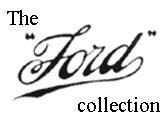The Model T Ford was certainly not the best American car, but it was the cheapest and most reliable.
A significant landmark in motoring history occurred on the 1st October 1908, the day Ford launched the Model T. For the sake of economy all other models were dropped. Gradually as the gamble paid off and the demand grew, the methods necessary to mass-production were applied to the new car. They were not new, having been applied in America to guns, watches and to motor cars by Henry Leland of Cadillac who had already preached and practised parts standardisation and interchangeability thanks to precision in manufacture. The precision was achieved by the development of specialised machine tools. Fords Detroit factory was at the time the largest and most modern in the world. From 1913, production took place in an extremely modern manner. The chassis was pulled through the factory on a rope. The various parts were fitted to it as it passed. Using this'conveyor belt' system meant cars could be produced quickly and cheaply. The company soon reaped the rewards for its efficiency and low unit costs and Ford began cutting his prices. In 1911 a Touring model cost $950, but by 1925 it was down to just $290, yet Ford still averaged $50 profit per car. In 1914 a Model T emerged from the factory every 40 seconds and in 1925 it was possible to deliver more than 9,000 in a day.
By 1926 Model T sales were flagging. As road conditions improved, customers wanted refinement and comfort rather than unsophisticated ruggedness. Ford could not accept that times were changing but, eventually, even he could not ignore falling sales. The last Model T came off the line on 31st May 1927 with the chassis number 15,176,888.
Ford opened a factory to produce Model T Fords in Manchester, in 1911. This was intended to reduce the production and transport costs. The model became a resounding success in England too. When the conveyor belt finally stopped in 1925, more than 250,000 Model T Fords had already been built inEngland.
In 1920 the British Government introduced a new tax system. From then on, the engine size determined the amount of tax payable. This was bad news for the model A in particular, as this had a big 3285cc engine. For this reason the AF was built specially for the British market with a smaller 2.0Ltr engine. Unfortunately, the AF was no competitor for the small Morris and Austin cars. Ford decided in 1932 to design a new model and a new factory was built at Dagenham to Produce the Model Y.

1/32nd scale kit.
Built by Rod.
Built in the 1950s and painted with Humbrol enamels. This is a very basic kit but quite average for the time of manufacture. Model car kits have come a very long way since the late 1950s. The block painting style of this model is typical of the time it was built. There wasn’t as much detail in the models then so there was little to be gained from using dry brushing and ink washes anyway.
Also noteable, mostly by there abscence, is the lack of any clear parts. No windscreen or headlamp lenses are in the kit. Although the technology in chemistry and engineering did allow for clear plastic it was at that time more expensive and very brittle compared to the coloured plastic. For a while some manufacturers just had to leave it out. So modellers took to making screen and lenses from clear acetate sheet but that rather depended on whether somebody past the idea on or even if you could get such materials. Being one of Rods early models it seems he hadn't yet heard of or read about this tip. Later he did use clear and coloured acetate for Wind screens.
RETURN TO -
